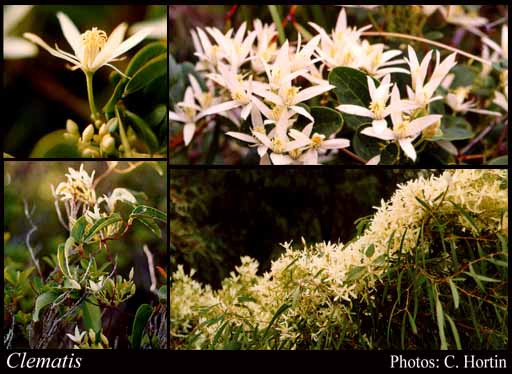- Reference
- Sp.Pl. [Linnaeus] 2:543 (1753)
- Name Status
- Current

Scientific Description
Common name. Clematis. Family Ranunculaceae.
Subfamily Ranunculoideae, Tribe Anemoneae.
Habit and leaf form. Shrubs (suffrutescent), or lianas, or herbs (rarely). ‘Normal’ plants. Leaves well developed. Plants with roots; unarmed; autotrophic. Perennial, or annual (rarely); to climbing to 6 m high. Climbing, or self supporting; petiole twiners. Mesophytic. Not heterophyllous. Leaves small, or medium-sized; opposite; with blades; long petiolate; simple, or compound; ternate, or pinnate, or bipinnate, or multiply compound. Leaflets variously shaped. Leaf blades neither inverted nor twisted through 90 degrees; pinnately veined. Leaves without stipules.
Reproductive type, pollination. Fertile flowers hermaphrodite, or functionally male. Unisexual flowers absent, or present. Plants hermaphrodite, or monoecious. Plants homostylous.
Inflorescence and flower features. Flowers aggregated in ‘inflorescences’, or solitary (rarely). Inflorescences terminal, or axillary; with involucral bracts, or without involucral bracts. Flowers pedicellate; medium-sized; regular; not resupinate; heteromerous. Free hypanthium absent. Perianth sepaline; 4(–8); 1 -whorled. Calyx present; 4(–8); 1 -whorled; polysepalous; variously coloured. Sepals ovate. Corolla absent. Androecium present, or absent. Fertile stamens present, or absent. Androecial members indefinite in number. Androecium 100 (‘many’). Androecium exclusively of fertile stamens, or including staminodes (‘petaloid’). Stamens 100 (‘many’); polystemonous. Anthers separate from one another; dehiscing via longitudinal slits; tetrasporangiate; appendaged, or unappendaged. The anther appendages apical. Fertile gynoecium present, or absent. Gynoecium 100 carpelled (‘many’). The pistil 100 celled (‘many’). Carpels increased in number relative to the perianth. Gynoecium syncarpous; synovarious; superior. Ovary plurilocular; 100 locular (‘many’). Gynoecium stylate. Styles free; simple; apical; persistent; hairy. Style hairs brush-like (‘plumose’). Stigmas 1 - lobed. Ovules 1 per locule.
Fruit and seed features. Fruit indehiscent; achene-like. Dispersal unit the seed. Fruit 50 seeded (‘many’). Seeds endospermic.
Geography, cytology, number of species. Adventive, or native of Australia. Not endemic to Australia, or endemic to Australia. Australian states and territories: Western Australia, South Australia, Northern Territory, Queensland, New South Wales, Victoria, Australian Capital Territory, and Tasmania. South-West Botanical Province, or Northern Botanical Province (rarely). A genus of ca 295 species; 4 species in Western Australia; ca 3 endemic to Western Australia.
Etymology. From the Greek for "vine shoot", on account of its climbing habit.